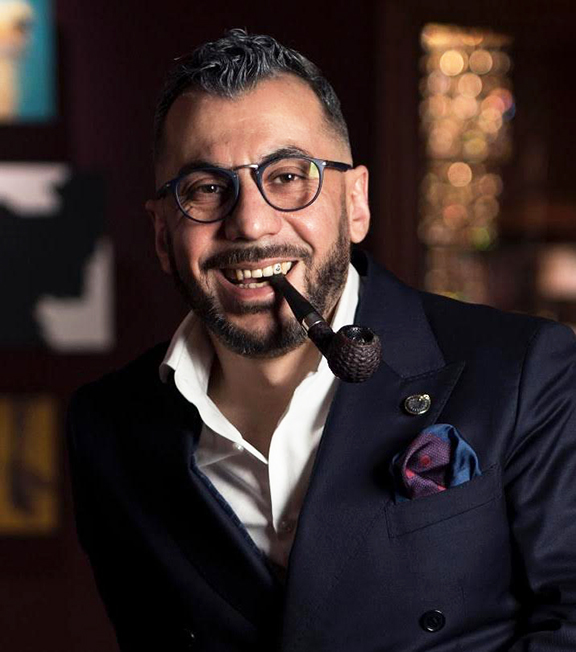Yerakouyn. By Sona Hamalian. Arman Nur’s “The Fly” is touring the world. The massive— i.e., human-size—sculpture made its debut at the 2017 Florence Biennale, winning the prestigious Lorenzo il Magnifico Gold Medal.
The following year, “The Fly” was shown at the Cafesjian Center for the Arts, in Yerevan. Over 7,000 people saw it during the multimedia exhibition which was unprecedented for the museum. Those who were there will tell you that perhaps the most characteristic reaction to the imposing sculpture was one of surprise and delight, a certain childlike bewilderment. Those visitors also had the opportunity to align their bodies with that of “The Fly,” to wear its limbs, as it were, in the manner of a skydiver wearing a wingsuit.
It was all about seeing the world from the perspective of someone—or, in this case, an insect—most of us don’t care much about. Why? Not only to gain deeper insight into what makes them who they are, but also, as Nur would suggest, to be poised to transcend the hatred that can fetter our intellectual and spiritual growth. To further demonstrate the point, the exhibition included a symbolic sculpture, in the form of a pair of eyeglasses, that complemented and amplified the large fly sculpture. After learning about the philosophical rationale behind the sculpture, visitors would actually wear the intricately-designed eyeglasses, thereby imagining, if not feeling, the experience of viewing the world through the eyes of a fly. “That experience has to do with being free to roam and explore the environment around us, without the need to live entrapped in our selfish, self-centered ways,” Nur explains.
From July 16 through 21 of this year, “The Fly” was exhibited at the RAI Amsterdam Convention Center, garnering critical acclaim. Next, the sculpture will be shown at the Art Nocturne Knocke, in Knokke-Heist (West Flanders), Belgium, beginning August 10. Art Nocturne Knocke is one of Europe’s most important art and antiquities fair. Given the now-iconic sculpture’s universal message of “understanding, forgiveness, and love,” Nur’s dream is to have it exhibited at the place still considered the very heart of international synergy, the United Nations headquarters, in New York. Nur has also designed a game featuring “The Fly” that was featured at the ICE London gaming convention, in February 2018.
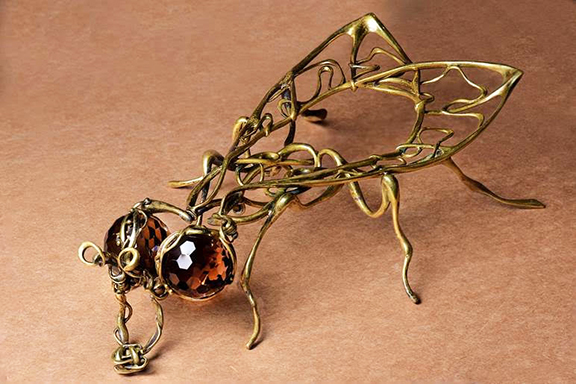
Nur’s “The fly,” made of bronze and topaz
Born in the Armenian capital in 1971, Arman Nur was educated at the Toros Roslin Applied Arts Institute, in Yerevan; the Moscow Institute of Gemology; and Miami International University of Art and Design.
Today, Nur is widely regarded as one of Armenia’s most innovative artists. He wears several hats: he is a designer, sculptor, jewelry maker, and painter. His evolving body of work—including sculptures and jewelry that often playfully tap into a broad range of art-historical references—is on display at his own exhibition space, the Nur Art Gallery, which has become a beloved cultural destination in Yerevan. Nur has shown his works throughout the world, with major solo exhibitions including the “Aratta” jewelry collection, shown at Erebuni, in Armenia; the Russian Fashion Week, for several years; and the “Uhi” collection, dedicated to Armenian women and shown at the Yerevan History Museum.
Nur has designed jewelry for numerous celebrities, among them Madeleine Albright, Andre Agassi, Cher, Montserrat Caballe, and Al Jarreau. As importantly, he has designed numerous public sculptures and other works. Among these are his sculpture titled “Childhood,” symbolizing health and happiness, at the Hematology Center of Yerevan; and his statue titled “The Reader,” created on the occasion of Yerevan’s designation as the 2013 “World Book Capital.”
Nur’s “Artashes” bracelet, made of gold, enamel, and volcanic foam
Nur’s works have garnered a string of distinguished accolades. They include being named “2004 Jeweler of the Year” in Moscow; winning the “Best Jewelry” award at the YUVELIR 2001 International Exhibition, in Moscow; and being bestowed two of Armenia’s top civilian honors, the Golden Medal of the Ministry of Culture of the Republic of Armenia and the Movses Khorenatsi Honorary Medal of the President of the Republic of Armenia.
Perhaps Nur’s most essential mantra is to never repeat himself. It’s what keeps him ever-curious and on his toes, the artist says.
Recently, I had the opportunity to speak to Nur at his gallery in Yerevan.
Sona Hamalian: You have designed hand-drawn T-shirts on which you expound the core ideas behind “The Fly” sculpture. One of those ideas is: “You must look through the eyes of the one who is hated, in order to understand, forgive, and love.” Can you elaborate a bit on the statements found on the T-shirts?
Arman Nur: The T-shirts constitute only a small part of “The Fly” project, and the ideology behind it is only partially presented on the T-shirts, including in my own handwriting. The totality of the concept can be understood only after viewing the project in its entirety—that is to say, not just the large fly sculpture, but also the many complementary works that give it further context. The key idea behind the project is that one must be able to love, not hate. Hatred hurts the hater, first and foremost. It stands to reason, therefore, that hatred must be replaced with love. We must strive to do this. And if we’re able to pull it off, we and the world as a whole will be the better for it. The basic vision of “The Fly” is: “If you can love the fly, you can love everyone and everything, and you’ll be able to fly.”

Nur’s “The Fly” is a life-size sculpture
S.H.: How would you describe the physical and emotional experiences of becoming one with the fly sculpture when you enclose your body within it? What do you feel? What do you imagine seeing?
A.N.: The human brain is designed in such a manner that we remember everything which we see for the first time. As we look through the eyes of the fly, it becomes clear that, for the first time, we’re seeing the world through the eyes of another being. The memory of this experience is indelibly etched in our mind. And if we reach a moment in our life when our hatred begins to hold us back from living life as we should, our memory brings us back the vision of the fly, which we’ve seen, helping us replace hatred with love.
S.H.: Since its debut in 2017, how, in general, have spectators responded to the compassionate and altruistic philosophy on which “The Fly” is based? And, in this respect, have you seen any key differences between spectators in Armenia and those in Europe?
A.N.: “The Fly” earned much praise at the Florence Biennale. I didn’t realize this at first, as I was busy explaining to spectators the ideology behind the sculpture. In fact, the whole of Florence was talking about “The Fly.” The exhibition had large numbers of visitors every day. As for differences between Armenian, European, and other spectators, I can say that Armenian spectators are quite restrained in expressing their impressions, whereas the reactions of European spectators tend to be much more emotional, direct, and frank.
S.H.: You have an abstract drawing of Yerevan in which the entire image is composed with a single line. This single line performs every compositional duty required of the work, from drawing some of Yerevan’s major cultural landmarks and thoroughfares to fleshing out everything in between. What prompted you to create this work? And do you plan on creating similar drawings dedicated to other cities?
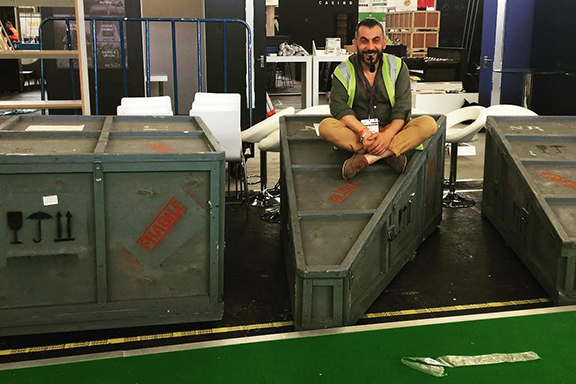
Arman Nur and his life-size fly land in Belgium
A.N.: Yes, the Yerevan drawing was executed with a single line. That’s my drawing technique, and I use it often. I call it “one line, one touch.” The Yerevan drawing is unique in the sense that it’s my largest canvas to date. I have worked on it for 12 hours nonstop. I expect to apply the same technique to draw all the cities in which “The Fly” is exhibited, as a way of commemorating the fact that the sculpture has been in these places. By using my “one line, one touch” technique for the Yerevan drawing, I have tried to reproduce the trajectory of a fly’s uncontrollable flight, which almost never is interrupted or cut short. The Yerevan drawing will be renamed “The Fly in Yerevan.”
S.H.: Your jewelry—be it a ring, a bracelet, an earring, a brooch, or a wedding crown—is as technically accomplished and intricately designed as it is boldly inventive. Would you agree that classical training is the cornerstone without which there cannot be sustainable creative audacity?
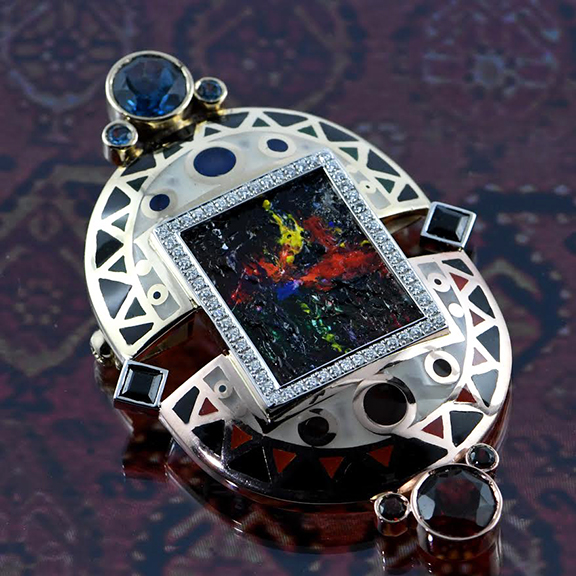
Nur’s “Day and Night” brooch, made of gold, diamonds, garnet, London topaz, sapphires, enamel, oil on canvas
A. N.: Without a doubt, every innovation is based on the established, the classical. And the value of innovation rests in the fact that it will eventually result in a cultural legacy for future generations. While my artistic sensibilities are very much rooted in the classical, I try to re-imagine and present it in a novel and inventive manner, in terms of subject matter, style, and technique alike.
S.H.: It is rather astonishing that every piece of jewelry you design is painstakingly handmade, can take a very long time to finish, and is one-of-a-kind. So how do you feel when a given piece is purchased by a client? Is there a feeling of loss involved? Or do you feel the piece has now been given a second life?
A.N.: I have thought about this often, and my answer is always the same: creating a work of art is akin to giving birth; and giving birth to a baby requires two people—one is myself, the jewelry maker, and the other is the person for whom the jewelry is being created. Therefore, by transferring a piece of jewelry to its wearer, I am “delivering” it to its second parent, without losing my connection with the thing created, and certainly without losing my connection with the person wearing it.
S.H.: The Nur Art Gallery has become an important artistic hub, and the central space where you exhibit your jewelry, sculptures, paintings, and multimedia works. How important is it for you to maintain a bond with the art-loving public, considering that such a bond can be enormously facilitated and nurtured by a space such as your gallery?
A.N.: I think art must educate and enlighten, and I think the Nur Art Gallery, as a Yerevan landmark, is profoundly committed to that vision. Accordingly, we organize exhibitions and various events through which we strive to help elevate the public’s artistic consciousness, by sharing with it the achievements of Armenian and world art.
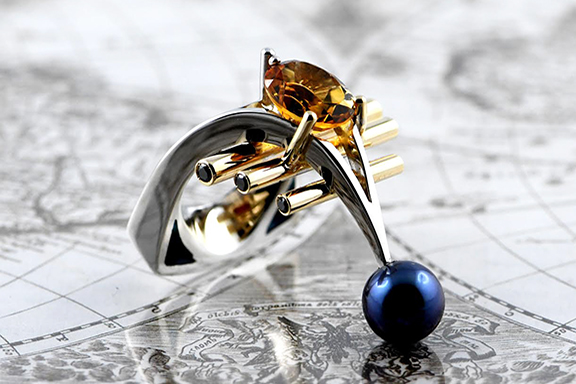
A ring made by Arman Nur
S.H.: Many of those who frequent your gallery also know that you’re an accomplished songwriter and musician. What role does music play in the bigger scheme of your artistic interests and output?
A.N.: Music is an inseparable part of myself, and an inseparable part of my work. That’s because in my artistic environment, and in my life in general, music is a constant presence and I consider myself not a musician per se but rather a music lover. As for songwriting, I’ve been doing it only recently. I don’t know where it came from or why. But it seems to me that in this particular stage of my life, I have a great need to express art through music as well; to explore, through songwriting and performance, fresh new avenues of creativity.
Photo – Yerakouyn




















































